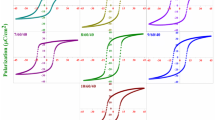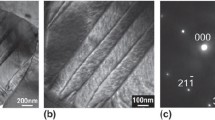Abstract
Electric fatigue, namely the decay of the polarization and the consequent elastic strain with increased number of switching cycles under high a.c. field, severely limits the applications of ferroelectric and piezoelectric materials in high-strain electro-mechanical actuators and in thin films used in non-volatile memory devices. Electric fatigue tests have been conducted on lead zirconate titanate (PZT) and lanthanum-doped lead zirconate titanate (PLZT) ferroelectric ceramics. It was found that electric fatigue can be initiated by various factors, the porosity being one of them. Electric fatigue occurred in low-density(93%–97%) PLZT 7/65/35 ceramics after 104 switching cycles, while the high-density (>99%) PLZT specimens of the same composition did not fatigue after 109 switching cycles. It was also observed that for PZT ceramics, fatigue proceeded much more slowly in the samples with higher density (∼98%) than those with lower densities (92%–96%). A tentative explanation for the origin of the fatigue mechanism associated with porosity is proposed.
Similar content being viewed by others
References
M. McQuarrie,J. Appl. Phys. 24 (1953) 1334.
W. J. Merz andJ. R. Anderson,Bell Lab. Record 33 (1955) 335.
J. R. Anderson, G. W. Brady, W. J. Merz andJ. P. Remeika,J. Appl. Phys. 26 (1955) 1387.
G. W. Taylor,ibid. 38 (1967) 4697.
Q. Y. Jiang, PhD thesis, Pennsylvania State University (1992).
Q. Y. Jiang, Wenwu Cao andL. E. Cross,J. Am. Ceram. Soc., in press.
E. Furman, PhD thesis, Pennsylvania State University (1987).
R. Waser, Tudor Baiatu andKarl-Heinz Hardtl,J. Am. Ceram. Soc. 73 (1990) 1645.
M. P. Harmer, Y. H. Hu, M. Lal andD. M. Smyth,Ferroelectrics 49 (1983) 71.
J. M. Herbert, “Ceramic Dielectrics and Capacitors” (Gordon and Breach, New York, 1985) p. 58.
E. Fatuzzio andW. J. Merz, “Ferroelectricity” (North-Holland, New York, 1967) pp. 102, 104.
R. Williams,J. Phys. Chem. Solids 26 (1965) 399.
A. Yu. Kudzin andT. V. Panchenko,Sov. Phys. Solid State 14 (1972) 1599.
D. S. Campbell,Philos. Mag. 79 (1962) 1157.
K. Lehovec andG. A. Shirn,J. Appl. Phys. 33 (1962) 2036.
Author information
Authors and Affiliations
Rights and permissions
About this article
Cite this article
Jiang, Q.Y., Cross, L.E. Effects of porosity on electric fatigue behaviour in PLZT and PZT ferroelectric ceramics. J Mater Sci 28, 4536–4543 (1993). https://doi.org/10.1007/BF01154968
Received:
Accepted:
Issue Date:
DOI: https://doi.org/10.1007/BF01154968




